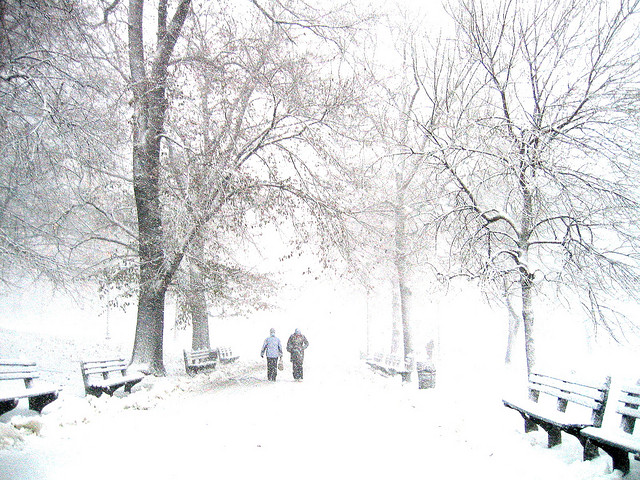
Photo by Adam via Flickr
“Dam!” “Dam!” “Dam!” No. I’m not swearing: I’m describing my Facebook feed this week. What was once filled with delightful photos of babies and cookie recipes from my friends in the Boston area (where I went to graduate school) now has shifted over the past month to feature snow and more recently, ice dams.
“What is an ice dam?” you ask. Oh, you lucky duck, be glad you don’t know! An ice dam is when ice builds up on your roof, blocks water from escaping through the downspouts, and sends it back into your house, popping out of ceilings and dribbling down walls. If you’re unlucky, it’ll freeze part of the way back through your house for optimal damage. If you are really unlucky, you have a flat roof that will collapse from the weight of the ice dams and snow.
You might have heard that the snow in Boston this year has been unbelievable (almost 96 inches this winter, with more on the way). It has paralyzed the city, shutting down schools, closing roads, and forcing public transportation to shut down. At first, it was fun for everyone, but fun has quickly turned to frustration with people getting trapped at home for weeks and the fear of collapsing roofs and water damage from ice dams.
But snow isn't the only problem. There are cities that get far more snow every year (Syracuse, New York, and Quebec City, Quebec, for example). The problem is the inadequacy of the infrastructure—the buildings and roads and the like in Boston were simply not built for this much snow. But if climate change will bring us snowier winters, then Bostonians, and people in places similarly afflicted, are going to need to start planning for the consequences now.
Inevitably there will be discussions, as the snow melts this spring, about how planners and builders in the Boston area need to prepare for snowier winters. No more flat roofs and better snow removal plans seem like an obvious start. But I wonder how quickly people will think about how to revamp science education to face a future filled with snowier winters.
Too often we are quick to point fingers at administrators and politicians who aren’t planning ahead. But maybe that finger should be pointed at us, if we fail to prepare students for a snowier future. What if, on the first day back from all these snow days, teachers took the opportunity for a teachable moment and asked their students: What types of facilities were affected by this event? How did it affect the economy in the Northeast? How was transportation affected? What do we need to do to make sure this doesn’t happen again?
Too often when we talk about climate change, we discuss the perils, and there is no question that increased snow in places like Boston is one of those perils. But what if we then asked students, “how can we adapt to these new circumstances?” What if we encouraged them to talk to policymakers to find out what they are doing about adaptation, or even to formulate their own ideas? This would help students not only think hard about their future, but also understand how they will be in charge of it. It is today’s students who will design roads, build new houses, and update tired infrastructure while the climate continues to change. Are we doing everything we can to prepare them for this? Are we giving them the training they need to solve these challenges? Are we telling them that soon they’ll be in charge and that they should thinking about solutions?
We need to plan now for a climate change future—and in Boston that means snow. Part of this planning involves the physical infrastructure of the city, but the other part is a civilian infrastructure, and that needs to start with the kids. Snow days are fun for the kids, but they are also harbingers of disruptive climate changes to come—and, by the same token, they can be teachable moments for all of us.

